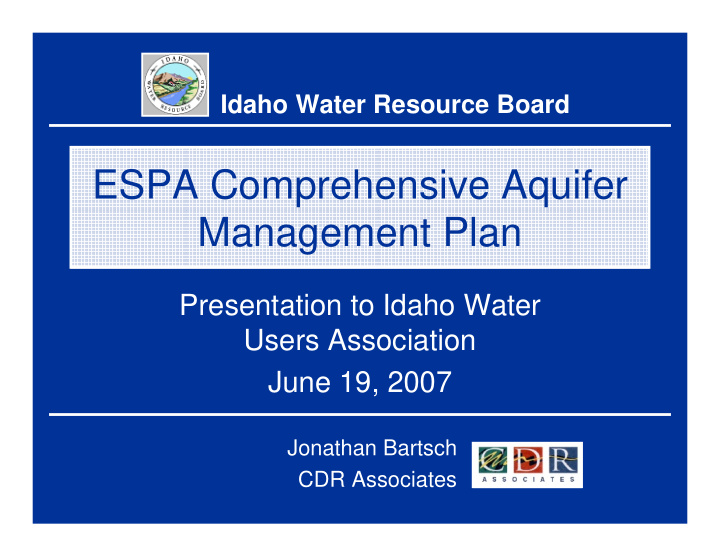



Idaho Water Resource Board ESPA Comprehensive Aquifer Management Plan Presentation to Idaho Water Users Association June 19, 2007 Jonathan Bartsch CDR Associates
Outline • Background: Framework Process – Goal and Objective • CAMP Advisory Committee Process – Advisory Committee Charge – Representatives and Governmental Agencies – Advisory Committee Roles – Tasks and Work Plan • Lessons Learned: Consensus Decision Making
ESPA Framework • Broadened public participation across the ESPA – public meetings and management alternative working group • Identified management alternatives and strategies in one document • Summarized input on how to fund management alternatives • Outlined qualitative Goal and Objectives
Goal for Aquifer Management Sustain the economic viability and social and environmental health of the Eastern Snake Plain by adaptively managing a balance between water use and supplies.
Objectives for Aquifer Management • Increase predictability for water users by managing for reliable supply • Create alternatives to administrative curtailment • Manage overall demand for water within the Eastern Snake Plain • Increase recharge to the aquifer • Reduce withdrawals from the aquifer
Advisory Committee Charge • Develop strategies and approaches to manage the ESPA that are acceptable to water users, • Make consensus recommendations to the Board for decision-making, • Inform and involve stakeholders regarding proposals, ideas and direction of the Advisory Committee.
Advisory Committee Representatives • Municipalities/Counties • Business • Land developers • Surface water users • Groundwater users • Spring water users • Hydropower • Domestic well owners • Environmental/Conservation • Mixed-Use • County Assessors
Governmental Participants • Bureau of Reclamation • Idaho Department of Water Resources • Idaho Department of Environmental Quality • Idaho Department of Fish and Game • Idaho Legislature and Governor’s office • US Fish and Wildlife Service
Advisory Committee Roles • Water Resources Board – Decision-making with recommendations from Advisory Committee and public • Advisory Committee Representatives – Deliberate and provide recommendations to Board – Coordinate with constituents/public • Governmental Agencies – Provide technical and policy input • Facilitators – Provide neutral, process support to reach outlined objectives – Encourage parties to develop agreements
Advisory Committee Tasks • Interim Targets. Develop recommendations for quantitative 5 and 10 year interim targets. • Management Actions. Develop recommendations for initial management actions to be taken to reach the interim targets • Funding Mechanisms. Develop recommendations for funding mechanisms • Adaptive Management. Develop recommendations for adaptive management mechanisms that will assess progress
Advisory Committee Work Plan – Interim Targets Interim Targets (3 - 5 months) – Consult with technical experts on range of water budget change necessary to achieve qualitative goal – Discuss with technical experts on water budget changes possible from various management alternatives over 5 and 10 year time frames – Using information provided, Committee recommends quantitative water budget change ranges for each objective in the 5 and 10 year time frames
Advisory Committee Work Plan – Management Actions Management Actions (4 - 6 months) – Technical experts provide information to assist Committee in identifying potential projects, expected outcomes, risk factors, costs, etc. – The Committee compares potential management actions with each other on a costs and benefits basis, including economic and other considerations. – Committee recommends prioritized projects and funding needs for each management action.
Advisory Committee Work Plan – Funding Funding Mechanisms (3 - 5 months) – Committee examines total funding required to meet 5 and 10 year quantitative goals. – Committee recommends funding strategy to provide resources necessary to implement management actions.
Advisory Committee Plan - Adaptive Management • Adaptive Management (1 - 2 month) – Committee recommends process for continuous evaluation of progress toward interim targets, including responsibilities
Lessons Learned • Clear direction and leadership regarding roles and expectations, • Good faith effort to understand and address needs, concerns and interests, • Convergence of Executive, Legislature, Board and public regarding ESPA management • Others?
Recommend
More recommend